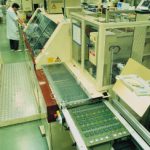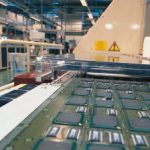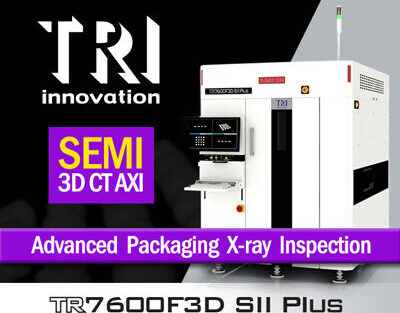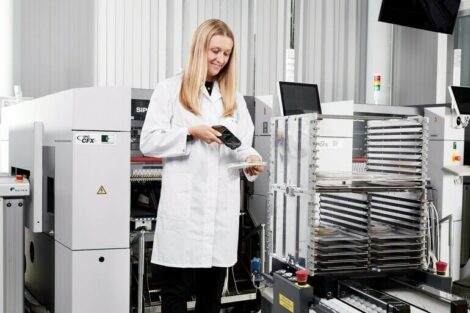EMS company ACT in France is now harvesting the benefits of its installed AOI equipment, but exploiting the potential requires a thorough understanding of what the technology can do. As production engineer Claude Floury underlines, „Pay attention to internal support, because AOI needs skills to work properly.“
Titus Suck, Adir Ariel, Orbotech
When a major customer advised ACT of Angers that its next product required automatic optical inspection, the company decided to make the investment. The purchase was approached with caution, as previous experience had been disappointing. A measured approach proved to be an astute decision, because getting the full benefit from AOI has required the development of a complete inspection strategy. The lessons it has learned about AOI have improved the company business; so, the decision was right. Its experience in successfully setting up a strategy is relevant to any user that has already installed, or is about to install, such a system. It is anexample of buying the correct equip-ment and building a concept for quality assurance (inspection and test). And it is about working with the supplier in order to get the best out of AOI and electrical verification such as in-circuit or functional test.
Combining inspection with electrical test
The investment in AOI resulted from a contract to build a complex, double-sided board (400 x 500mm). The bottom side was home to hundreds of passives, and the topside housed dozens of BGAs and QFPs. „We needed AOI to supplement ICT because the customer was doing his own functional test,“ explains Claude Flouryof the process engineering department. „Nonetheless, we still have to deliver a 100% working product, and the only way to do that without the back-up of functional test is to maintain total control of the process. We do this by fully exploiting a combination of AOI and ICT to achieve the highest level of test coverage.“ In response to the demand for zero defects, the company has developed an innovative inspection regime. During top-side assembly, each board is subject to a sample 2D inspection by the stencil printer’s on-board unit, followed by comprehensive 3D solder paste inspection. This inspection machine maintains output because it is faster than the printer unit.
Paste inspection is routinely performed as process control, but also because ACT doesn’t usually execute X-ray inspection of BGAs. Although AOI systems are not able to inspect BGA joints because line-of-sight access is blocked by the component, optimum yield can be assured if paste volume is consistently and accurately printed. „BGAs should give improved yield because of the relatively coarse pitch compared with fine-pitch QFPs. However, we have found that the yieldat the line end needs to be 100-timesbetter than with QFPs to make the pro-cess economic, since we can’t optically inspect the BGAs, and their rework is very expensive.“
When is pre-reflow inspection needed?
Floury doesn’t consider pre-reflow inspection necessary. He explains that it is only useful as a metrology tool, in other words, for checking placement machine drift and missing components. „It’s better to control that at the machine itself.“ At ACT, this is performed by a weekly calibration on the placement machine. But in contrast, he considers post-reflow inspection vital. For the complex topside of the telecoms assembly, the boards are subject to 100% optical inspection, exclusively using Orbotech machines. With seven in all, some are the VT8000 model and others the enhanced VT8000X. Five of them are located at line ends of the most complex products, while two others are serving as stand-alone stations.
End-of-line AOI performs a 100% inspection of the topside of the board that houses fine-pitch QFP and BGA devices. „It is extremely important to have a good machine at the exit of the line in order to feed straight back any deficiencies in assembly,“ explains Floury. „It has to happen in real-time so that the process can be changed quickly to minimize the cost of error.“ The second, less complex side, is subject to 100% inspection of a small sample of the first boards from the batch to verify the process. Thereafter, the second side of the board is 100% inspected by one of the off-line machines after completion of all assembly steps. This allows the full power of AOI to be utilised to check connectors, release mechanisms and fixing screws, for example.
Close relationship proved to be mandatory
The telecom board is heavy, and the worktable of the AOI machine needed modifying to cope with the weight. „The problems have been addressed to our satisfaction. There is a strong willingness fromOrbotech to support us. In situations like this it is very important to speak directly to the machine supplier.“ This example emphasizes the need for users to select a supplier with whom they can work closely. A high level of support is also critical in the early days of AOI commissioning. Floury stresses that this need is in turn most acute during inspection program development. In his experience, it is possible to get a machine up to a 95% operational level after a few days. Then a user will typically begin to run into problems that are no fault of the machine itself, more of the lack of standards for components. So-called identical parts don’t look identical. It’s a simple job to inspect whether a component is present, but when it comes to determining whether it has the correct polarity, or whether it carries the expected product code, that’s another matter. The component manufacturers have to be prepared to play their part if the situation is to improve, but at present, they don’t seem to want to get involved. This puts the onus on the AOI supplier. So, Orbotech is working hard to build an ever more comprehensive part library.
In addition, board design changes may introduce variations into solder joint profiles. AOI uses the profile history to create and update a statistical model that serves as the basis for its detection process. Orbotech machines are projected to track small variances characteristic of a specific users process and environment. Consequently, if the machine suddenly returns an unusual number of false calls, it is good practice to first look whether anything in the process has changed. For example, the AOI machine may react to a solder joint that is acceptable, but whose physical appearance has changed. This means the machine can do more than solely identify defects, that it can also serve as a strong process-monitoring tool.
AOI’s original sin: the false call issue
Another area that needs the supplier’s input is in the permanent reduction of false calls. All AOI systems strike a compromise between detection depth, false calls and speed. Consequently, there will be false calls. But a well thought-out repair concept can help to control the problem. Orbotech’s approach is to customize the AOI system, so that defect interpretation is made according to the customer’s specific process and solder joint formation profile. Orbotech actively works with users to tune the machine software to fully optimize performance. This means that acceptable „defects“ – objectively flaws but deemed tolerable relative to the process – are first verified and then reclassified at the repair station as good, and then reintegrated into the detection program. This approach reduces false calls and effectively minimizes the occurrence of escapes. The next generation of software includes an advanced classification feature. This works in parallel with the current fault classification algorithms using the same information gathered from the original image (without slowing the machine down as a high resolution retest would). It won’t improve detection, but it will remarkably minimize false calls.
ACT demands more from its supplier than most and consequently the current performance from the Orbotech machines is impressive. On a huge A3 sized board with thousands of components and tens of thousands of solder joints, the machine is able to detect all board defects. Floury believes that with continued support, he can also reduce the false calls significantly. „There is no other way of inspecting these boards; they are now way beyond the capabilities of human inspectors.“ Nonetheless, the subject of false calls can be perplexing, and it demands an effective rework strategy because no AOI machine can eliminate the problem. He has analyzed the extent of the defects and found that in the early days, 30% of all false calls had been erroneously classified by the rework staff, and then were revealed as real defects at ICT.
Inspection regime helps to exploit
„Any inspection regime has to go further than just AOI. Genuine faults can be detected by the machine and then be wrongly classified by the operator. To give an example, the placement machine may mount the wrong resistor; this would pass at AOI but fail at functional test. Therefore, if you’re not performing functional test you need to cover for this by performing extra verification of the component feeders. Try to cover for all eventualities,“ Floury states. „For example, take the case of BGA orientation. Ask the question ‚does the placement machine check this?‘ If not, does AOI? If that doesn’t, is the orientation detected at ICT? Do this to make sure that there is at least one test stage that will pick-up on such a problem and maintain full test coverage.“ Fault type ‚zoning‘ has other benefits. It allows the problem to be discovered at the earliest stage; it cuts down on duplication that might mean reducing the need for ICT coverage, and it helps to reassure customers that nothing will be missed.
ACT’s experience proves that getting the most from AOI takes time and skilled engineering effort. The machines aren’t perfect from the first day, but it is possible to incrementally improve their performance over time. As Floury notes, „Before you criticize the performance, just remember how difficult it was before the technology was available.“ ACT has witnessed improvement in yields – typically 10% increase at ICT (from 80 to 90%) – and has made cost savings because finding a category of fault at the AOI stage is cheaper than finding the same fault at ICT. In addition, shorter test times at ICT have increased productivity.
Floury admits that he was reticent to move to AOI, and had to be „pushed by the customer“. For the decision he looked for a supplier, and in addition to fulfilling the technical criteria, was able to provide local support. Orbotech’s willingness to program the benchmark board won the company the order. „We have moved our production forward. Pay attention to internal support, because AOI needs skilled attention to work properly. Remember AOI is not ICT – that is black and white. While AOI can return pass/fail judgments, it can also be ‚don’t yet know‘. When selecting a supplier, don’t just listen to the sales hype, try to get them to highlight the weaknesses of the technology as it stands today, and then ask how they will help you over-come these challenges. Orbotech has always done that and that’s why we have continued to work through some difficult times. And because of this I wouldn’t hesitate to recommend this supplier to another company.“
EMS company caught in the act
ACT, a US-headquartered company, bought a Bull Computers site in Angers two years ago. The addition of the French facility increased its complement of SMT lines from 48 to 59. „We are much smaller than the top two EMS‘, but ACT is a top-ten contract manufacturer worldwide and we intend to expand rapidly,“ explains manufacturing director Patrick Tonon. ACT is focused on high technology. For example, the EMS specialist has been placing ceramic BGAs since 1994, and today is using CCGAs with 1647 I/Os and columns on a pitch of 1mm. For the factory, it is apparent that little has been spared in the race to stay competitive. A high-technology line can comprise of highend stencil printer, 3D solder-paste inspection unit, chipshooters supplemented by flexible placers, multi-zone reflow oven and post-reflow AOI.
ACT doesn’t compete in the very high-volume, low-margin game, but prefers to service the technology-hungry networking, telecom and datacom markets. Typically, these sectors demand large, double sided assemblies that exploit dozens of BGAs, µBGAs (0.8mm pitch), CSPs (0.5mm), QFPs with up to 304 leads (0.5mm), and many other QFPs with 0.4mm lead pitch. Those boards are also populated with a plethora of electromechanical parts such as high-density connectors. The company uses every component currently available, including ultra-small passives.
Electronics manufacturing service (EMS) companies have to offer a full and flexible range of production capabilities, demonstrating the expertise to cope with even the most complex products. The speed of technological advance is such that current capital equipment won’t necessarily be able to make tomorrow’s products. Remaining competitive demands an ability to predict technology development. Nevertheless, this is risky, as it is all too easy to invest in equipment that will quickly prove to be technologically obsolete. One way of minimizing this risk is to listen closely to customers, understand their product roadmaps and their demand for equipment.
Zusammenfassung
Anwender mit Erfahrung aus dem elektrischen Test staunen, mit welcher Konsequenz AOI-Programme permanent zu debuggen sind. Die Stabilität elektri-scher Testprogramme erreichen sie nicht. Eher scheint es so: je featureintensiver ein AOI-System, um so höher der Debuggaufwand, den die Anbieter gerne als Tuning bezeichnen. In dieser Applikationsstory wird deutlich, daß Support einen immens hohen Stellenwert aufweist. Ein Interessent soll nicht Hochglanzverlautbarungen von Anbietern vertrauen, sondern muß klar die Vor- und Nachteile dieser Technik sowie des potentiellen Systems diskutieren und danach eine plau-sible QS-Strategie installieren.
Résumé
Les utilisateurs expérimentés dans le domaine du test électrique s’étonnent de la nécessité de débuguer en permanence les programmes AOI qui n’atteignent pas la stabilité des programmes de tests électriques. Bien au contraire, il semble que plus un système AOI est performant, plus il est nécessaire de le débuguer souvent, une opération que les vendeurs de programmes présentent volontiers comme un tuning. Cet article montre le rôle extrêmement important que joue le support. L’acheteur intéressé doit se méfier des déclarations optimistes des vendeurs et étudier en toute connaissance de cause les avantages et les inconvénients de cette technique de même que du système potentiel pour définir une stratégie d’assurance qualité adaptée.
Sommario
Gli utilizzatori con esperienza nei controlli e prove elettriche sono sbalorditi dalla coerenza con cui viene permanentemente eseguito il debug dei programmi AOI. Essi non sono in grado di raggiungere la stabilità di programmi di controllo elettrico, al contrario: più un sistema AOI è dotato di funzioni, maggiore è l’impegno di debug, denominato volentieri „Tuning“ da parte delle aziende che offrono tale servizio. In questa storia d’applicazione si rivela la notevole importanza rivestita da un servizio di assistenza, il cosiddetto Support. Ogni interessato non deve credere ciecamente nelle promesse lungimiranti dei produttori ma discutere chiaramente i vantaggi e gli svantaggi di questa tecnica cosìccome del potenziale sistema e installare poi una plausibile strategia di assicurazione della qualità.
Share:












